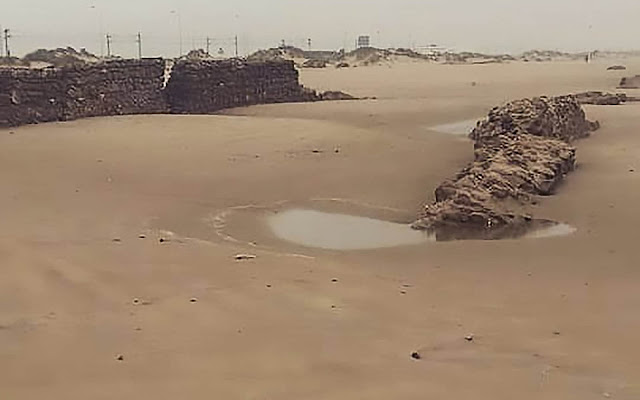There is a famous song by Antonio Rodríguez Martínez, aka El Tío de la Tiza, that was sung at the Cádiz carnival of 1905 chronicling a fisherman’s discovery of 18th-century coins at La Victoria beach. In the song, locals rush in with shovels to extract the valuable coins from the sand.
 |
| Architectural remains uncovered by the recent storm in Cádiz [Credit: ADIP] |
“We were alerted to the presence of these remains, and to the fact that people were digging in the area, so we went there, warned people to stop what they were doing, and called city officials,” explains Moisés Camacho, president of the Association for the Investigation and Dissemination of Cádiz’s Heritage (Adip).
Soon after that, the municipal archeologist and a local police patrol car showed up to watch over the remains on a stretch of beach that runs parallel to the road connecting Cádiz and San Fernando.
 |
| The Roman road and aqueduct were discovered near the beach of Cortadura [Credit: CEN/ADIP] |
This road was used until 1755, when it was destroyed by a tidal wave triggered by the great earthquake in Lisbon. The tsunami swept through Cádiz and Huelva, killing 1,240 people.
Not two meters from this road, archaeologists have identified up to seven fragments of what might have been the aqueduct of Gades (the Latin name for modern-day Cádiz), a Roman construction built in the first century. “Two of these fragments are still joined together with the original mortar, which is a rare occurrence,” said Camacho.
 |
| The modern epoch road that the temporary 'Emma' has left visible in Cádiz [Credit: Silvia Manito Velázquez] |
The Roman aqueduct of Cádiz once stretched over 75 kilometers, bringing residents water from the springs of Tempul, in San José del Valle. It is considered one of the greatest feats of engineering in Roman-era Hispania. Other similar aqueduct fragments found years ago are now on display in Cádiz’s Asdrúbal square.
Scholars believe that there could also be an older Roman road right underneath its 17th-century counterpart, or else running parallel to it under the sea.
Author: Susana Urra | Source: El Pais [March 06, 2018]
